Isolation of lignans and neolignans from Pouzolzia sanguinea with their cytotoxic activity
One lignan (7′S,8′R,8S)-4,4′-dihydroxy-3,3′,5,5′-tetramethoxy-7′,9-epoxylignan-9′-ol-7-one (1) together with four
neolignans (7α,8α)-dihydrodehydrodiconiferyl alcohol 9-O-β-D-glucopyranoside (2), (7α,8α)-dihydrodehydrodiconiferyl alcohol 9′-O-β-D-glucopyranoside (3), icariside E3 (4), and icariside E5 (5) were isolated from Pouzolzia
sanguinea. Their chemical structures were elucidated by ESI-MS, NMR spectra, as well as in comparison with the data
reported in literature. At concentration of 30 µM, compounds 1-5 exhibited weak cytotoxic activity with cell viability
percentages ranging from 59.9±0.98 % to 84.2±0.98 % and from 77.7±0.81 % to 100.3±0.78 % on CAL27 (oral
adenosquamous carcinoma cell) and MDA-MB-321 (breast cancer cell) cell lines, respectively.
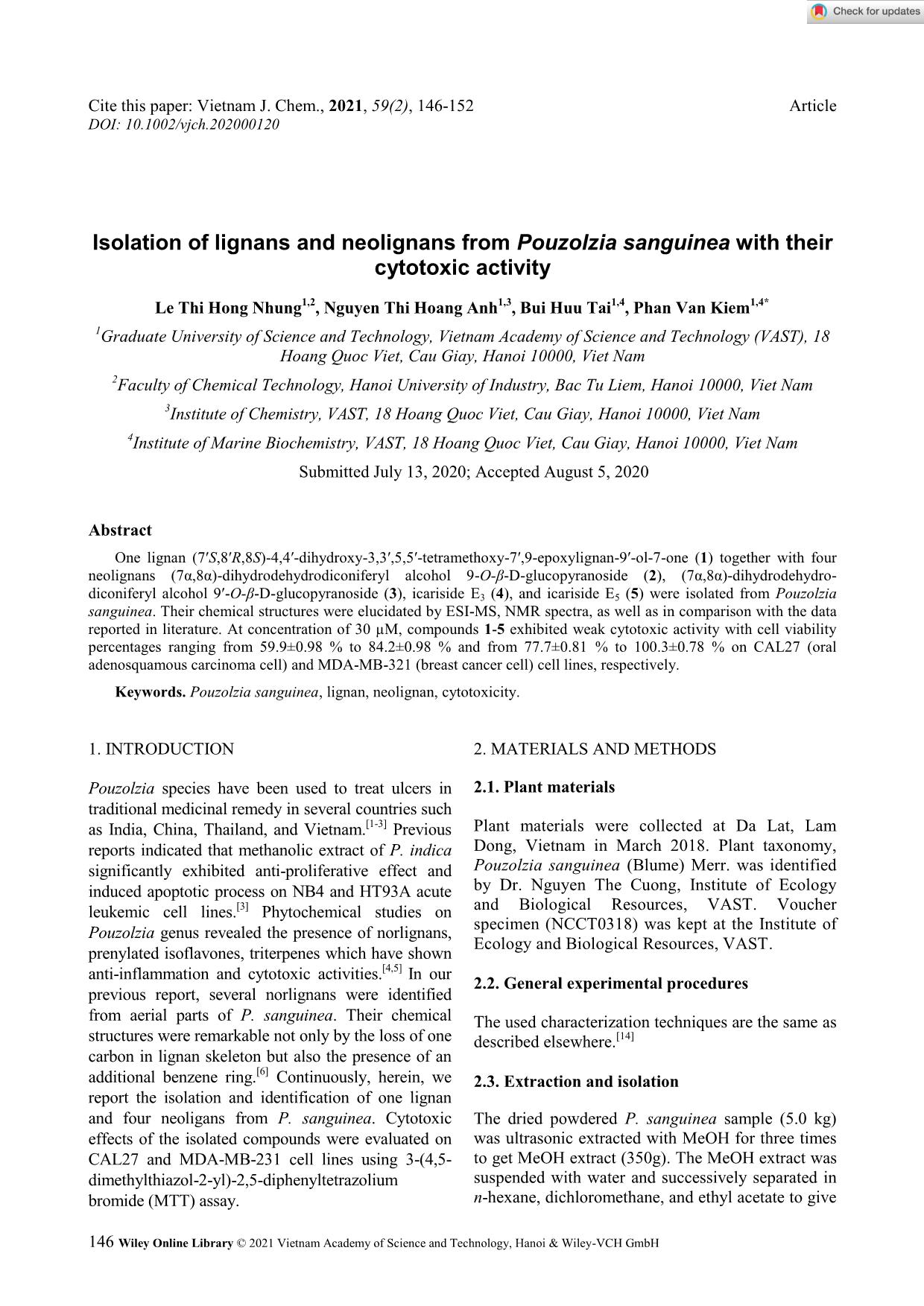
Trang 1
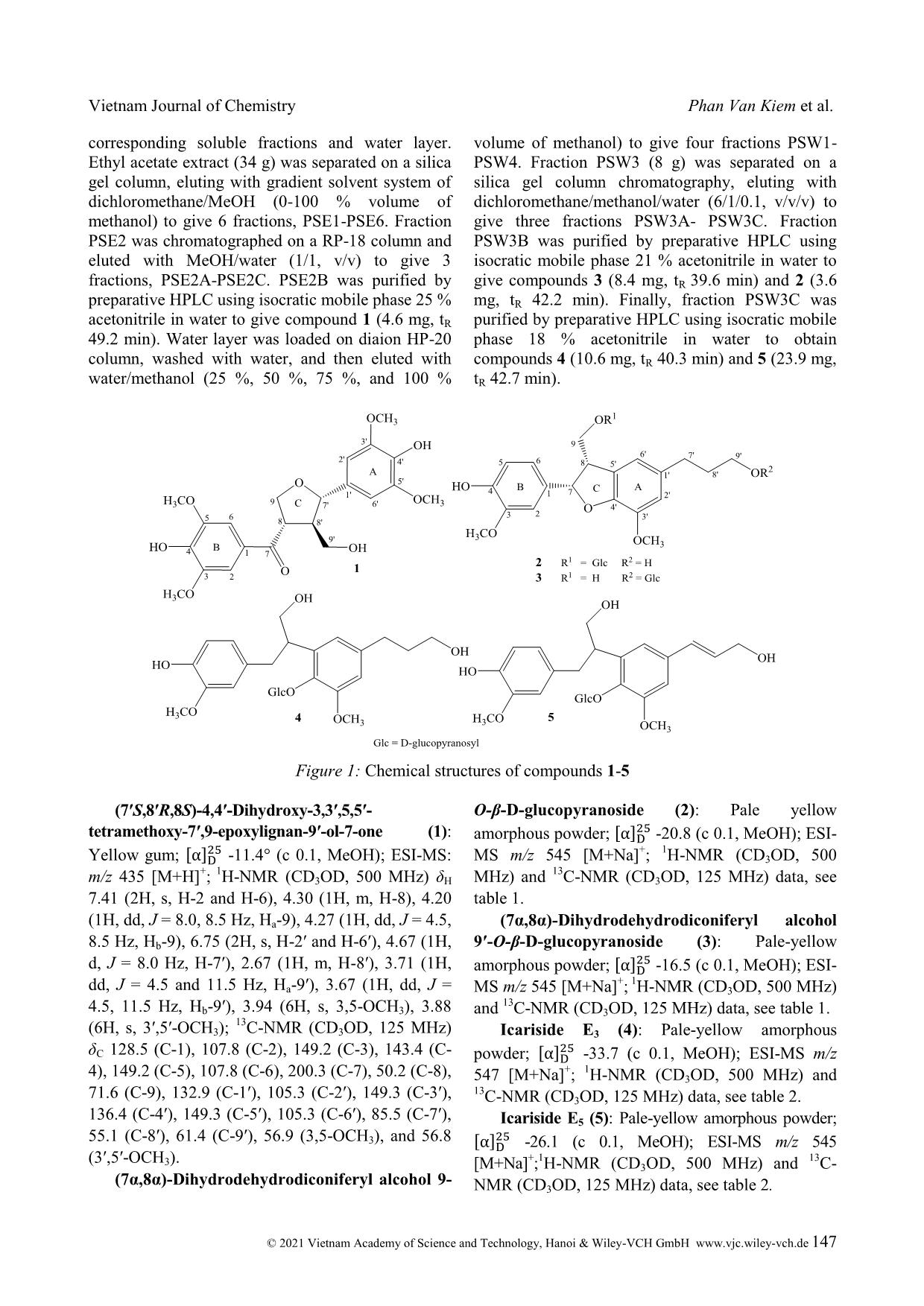
Trang 2
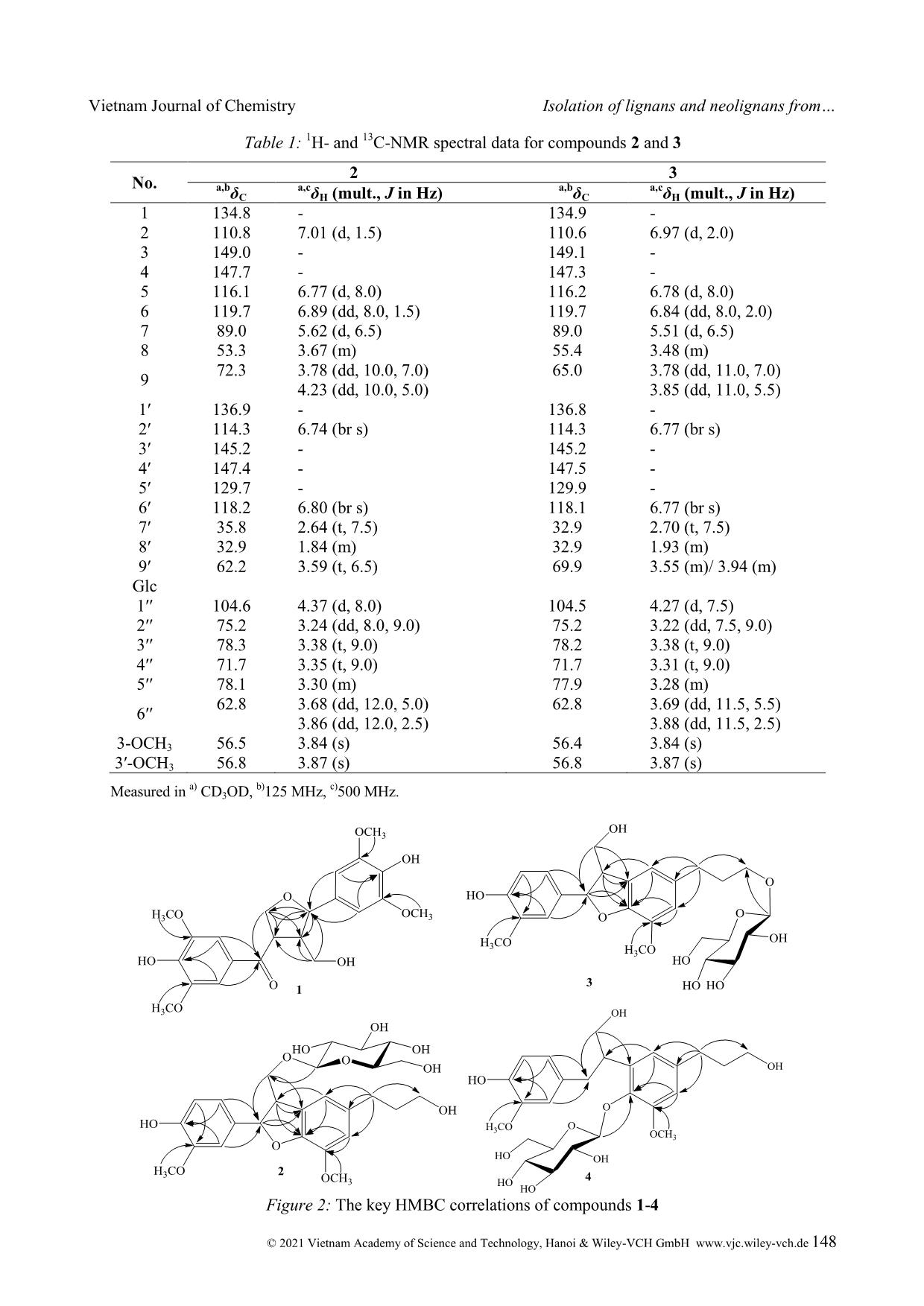
Trang 3
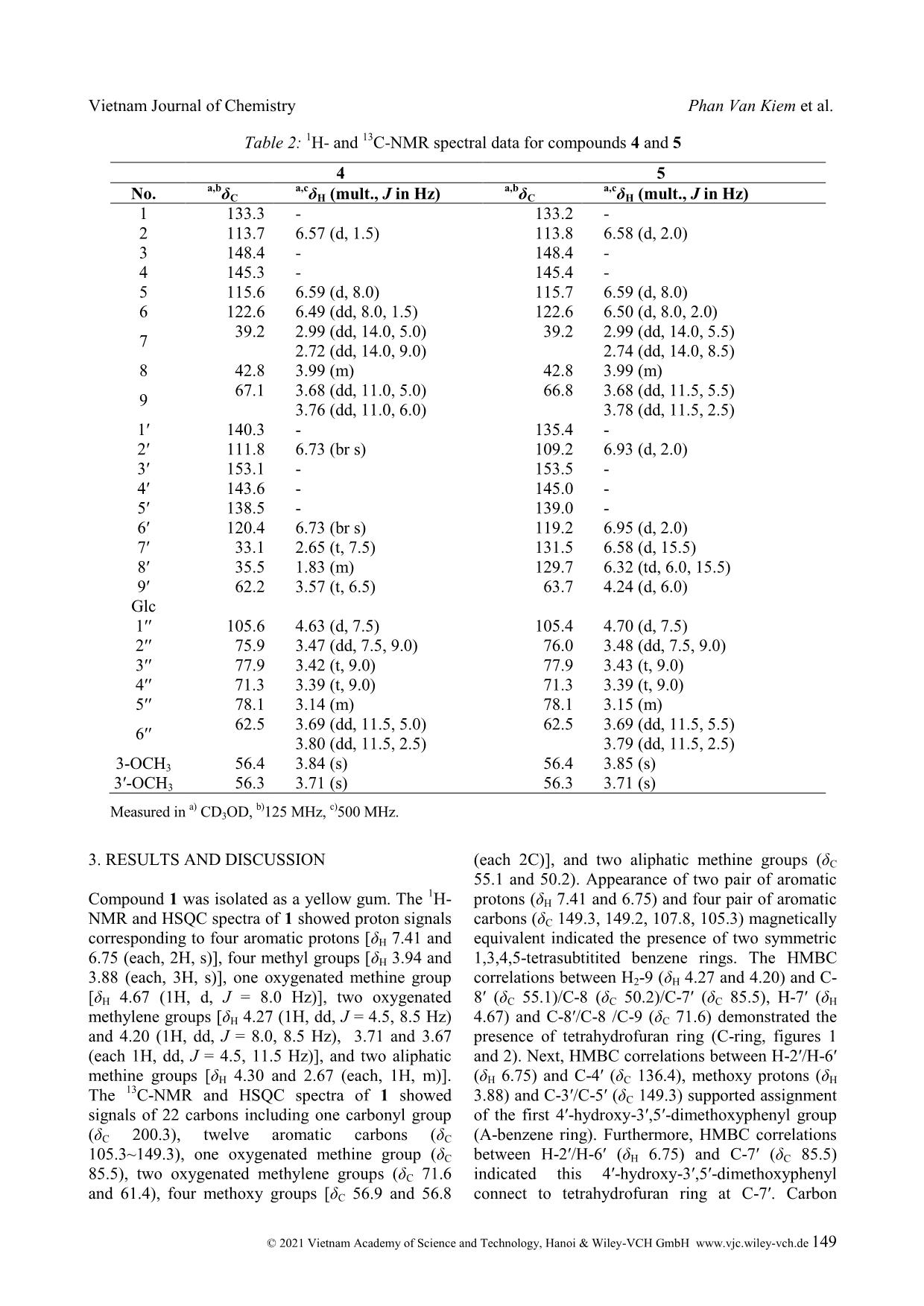
Trang 4
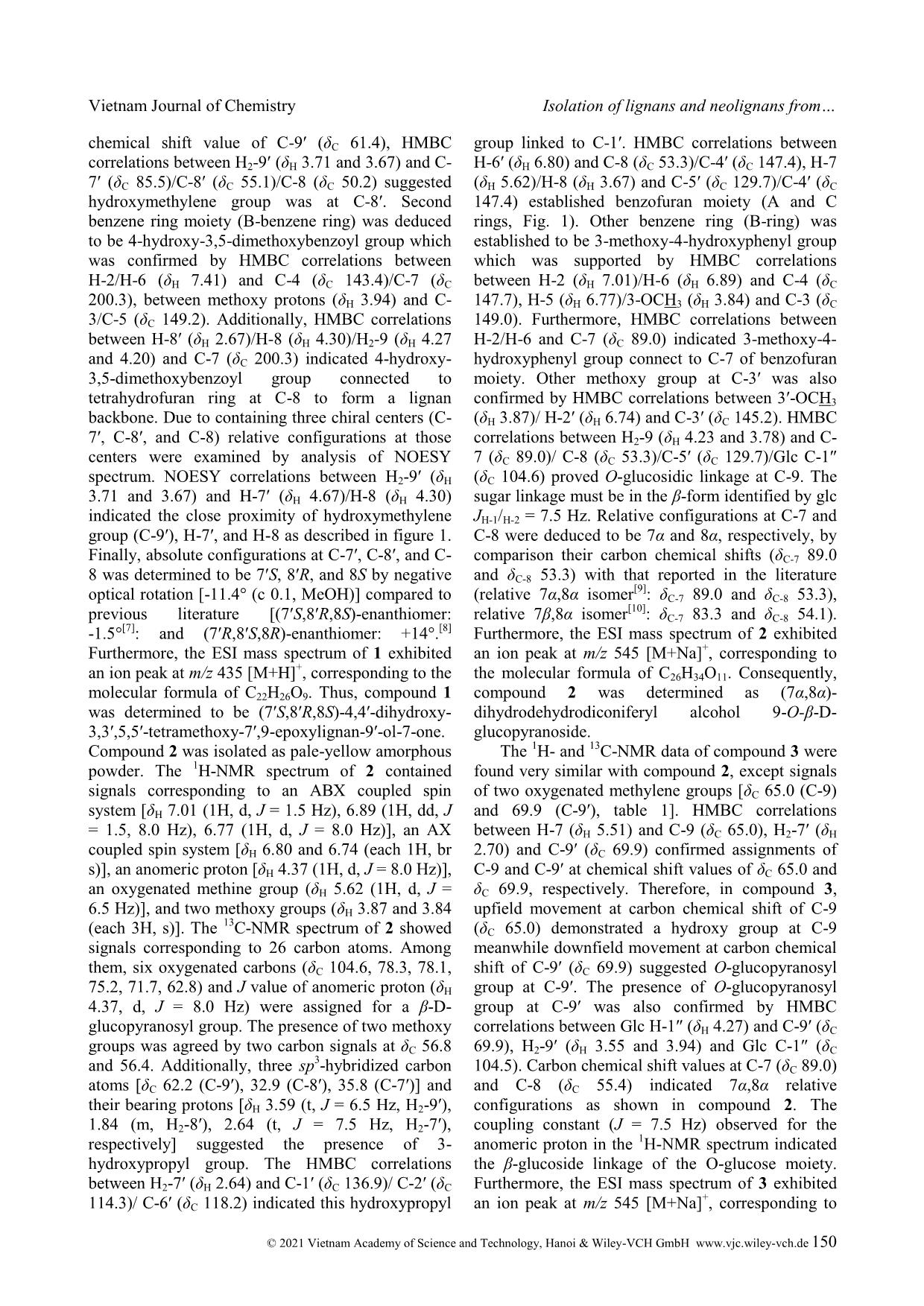
Trang 5
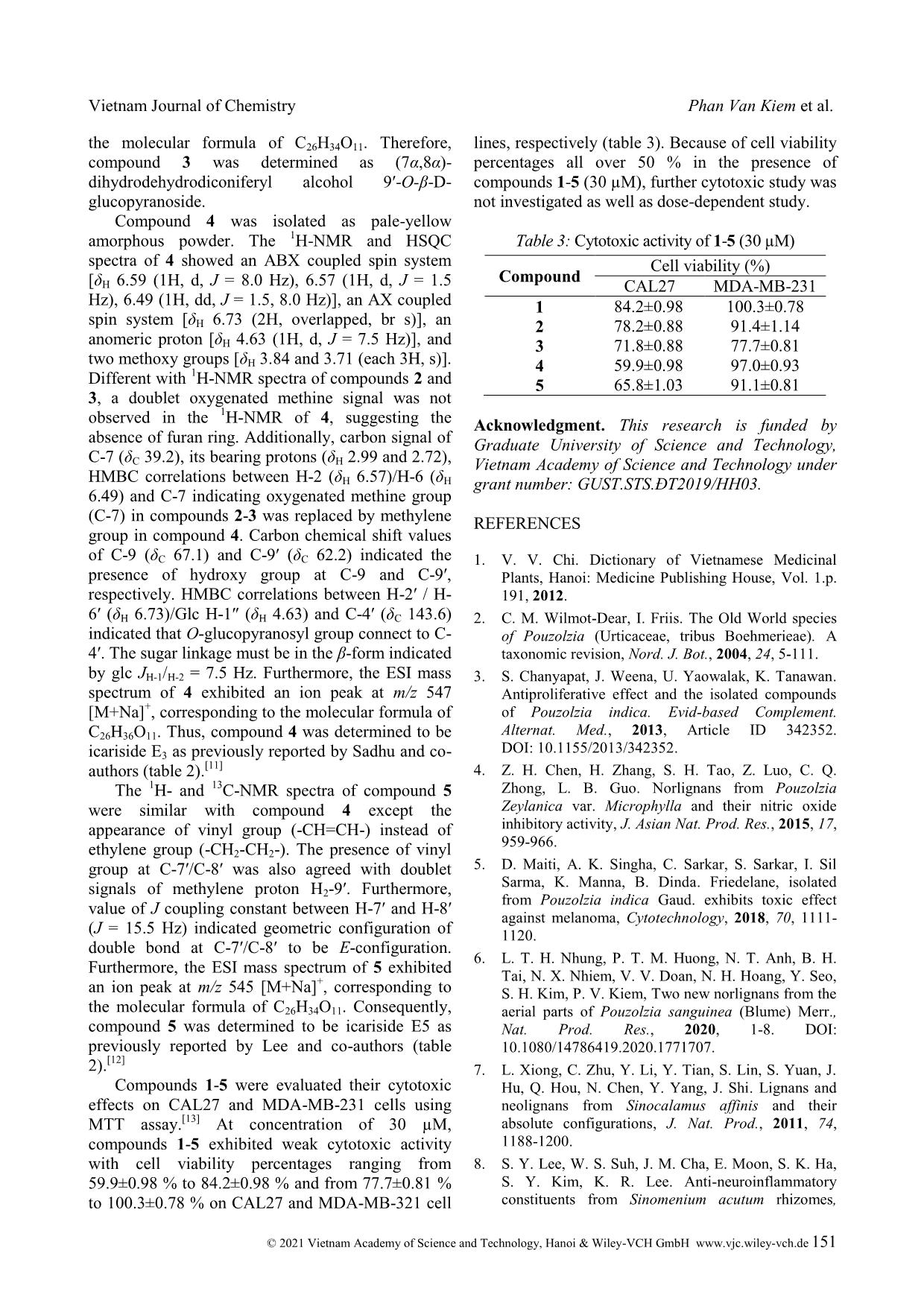
Trang 6
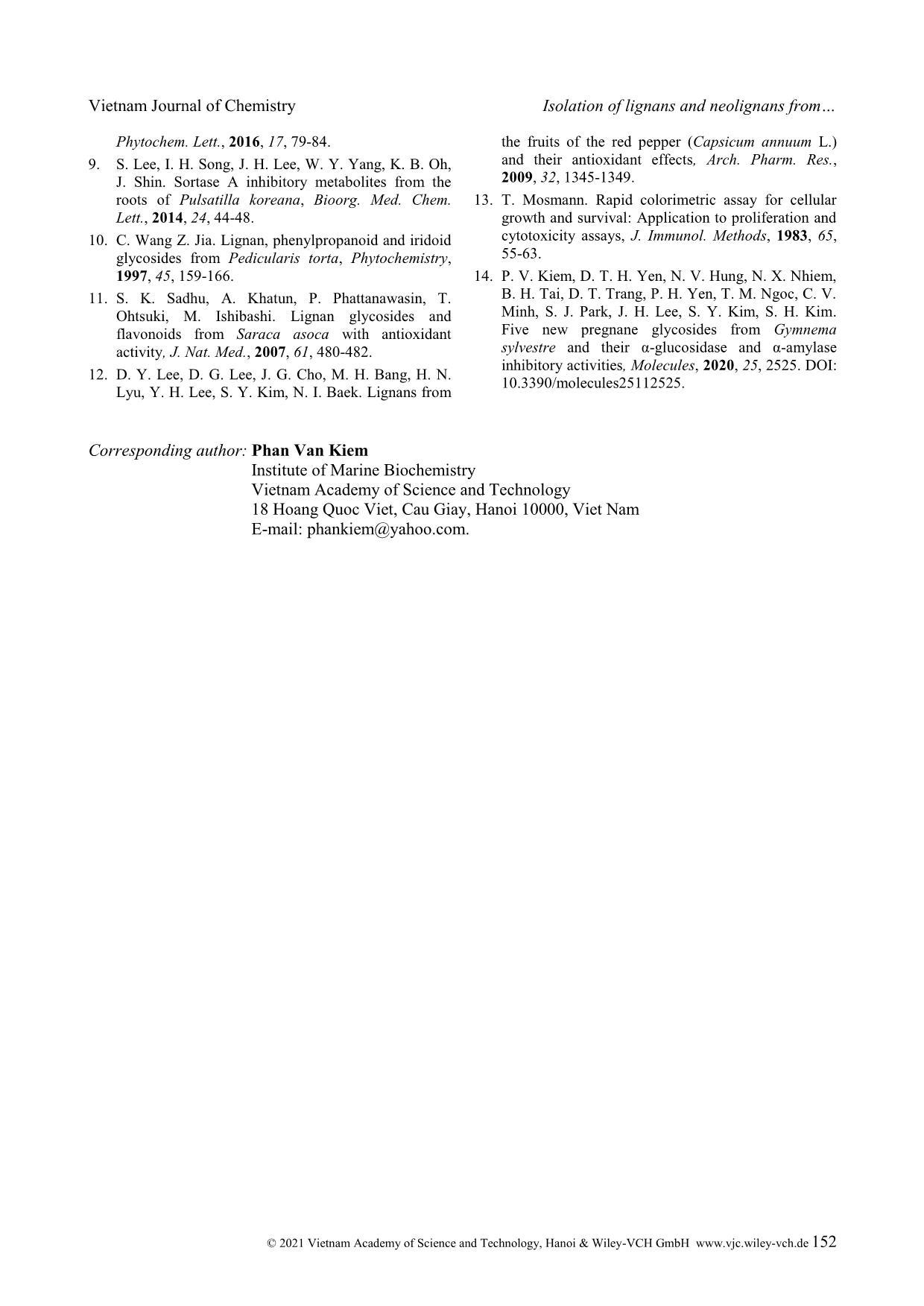
Trang 7
Tóm tắt nội dung tài liệu: Isolation of lignans and neolignans from Pouzolzia sanguinea with their cytotoxic activity
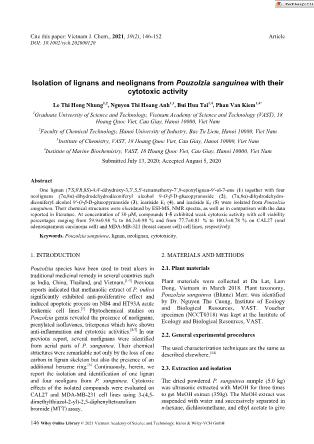
Cite this paper: Vietnam J. Chem., 2021, 59(2), 146-152 Article DOI: 10.1002/vjch.202000120 146 Wiley Online Library © 2021 Vietnam Academy of Science and Technology, Hanoi & Wiley-VCH GmbH Isolation of lignans and neolignans from Pouzolzia sanguinea with their cytotoxic activity Le Thi Hong Nhung 1,2 , Nguyen Thi Hoang Anh 1,3 , Bui Huu Tai 1,4 , Phan Van Kiem 1,4* 1 Graduate University of Science and Technology, Vietnam Academy of Science and Technology (VAST), 18 Hoang Quoc Viet, Cau Giay, Hanoi 10000, Viet Nam 2 Faculty of Chemical Technology, Hanoi University of Industry, Bac Tu Liem, Hanoi 10000, Viet Nam 3 Institute of Chemistry, VAST, 18 Hoang Quoc Viet, Cau Giay, Hanoi 10000, Viet Nam 4 Institute of Marine Biochemistry, VAST, 18 Hoang Quoc Viet, Cau Giay, Hanoi 10000, Viet Nam Submitted July 13, 2020; Accepted August 5, 2020 Abstract One lignan (7′S,8′R,8S)-4,4′-dihydroxy-3,3′,5,5′-tetramethoxy-7′,9-epoxylignan-9′-ol-7-one (1) together with four neolignans (7α,8α)-dihydrodehydrodiconiferyl alcohol 9-O-β-D-glucopyranoside (2), (7α,8α)-dihydrodehydro- diconiferyl alcohol 9′-O-β-D-glucopyranoside (3), icariside E3 (4), and icariside E5 (5) were isolated from Pouzolzia sanguinea. Their chemical structures were elucidated by ESI-MS, NMR spectra, as well as in comparison with the data reported in literature. At concentration of 30 µM, compounds 1-5 exhibited weak cytotoxic activity with cell viability percentages ranging from 59.9±0.98 % to 84.2±0.98 % and from 77.7±0.81 % to 100.3±0.78 % on CAL27 (oral adenosquamous carcinoma cell) and MDA-MB-321 (breast cancer cell) cell lines, respectively. Keywords. Pouzolzia sanguinea, lignan, neolignan, cytotoxicity. 1. INTRODUCTION Pouzolzia species have been used to treat ulcers in traditional medicinal remedy in several countries such as India, China, Thailand, and Vietnam. [1-3] Previous reports indicated that methanolic extract of P. indica significantly exhibited anti-proliferative effect and induced apoptotic process on NB4 and HT93A acute leukemic cell lines. [3] Phytochemical studies on Pouzolzia genus revealed the presence of norlignans, prenylated isoflavones, triterpenes which have shown anti-inflammation and cytotoxic activities. [4,5] In our previous report, several norlignans were identified from aerial parts of P. sanguinea. Their chemical structures were remarkable not only by the loss of one carbon in lignan skeleton but also the presence of an additional benzene ring. [6] Continuously, herein, we report the isolation and identification of one lignan and four neoligans from P. sanguinea. Cytotoxic effects of the isolated compounds were evaluated on CAL27 and MDA-MB-231 cell lines using 3-(4,5- dimethylthiazol-2-yl)-2,5-diphenyltetrazolium bromide (MTT) assay. 2. MATERIALS AND METHODS 2.1. Plant materials Plant materials were collected at Da Lat, Lam Dong, Vietnam in March 2018. Plant taxonomy, Pouzolzia sanguinea (Blume) Merr. was identified by Dr. Nguyen The Cuong, Institute of Ecology and Biological Resources, VAST. Voucher specimen (NCCT0318) was kept at the Institute of Ecology and Biological Resources, VAST. 2.2. General experimental procedures The used characterization techniques are the same as described elsewhere. [14] 2.3. Extraction and isolation The dried powdered P. sanguinea sample (5.0 kg) was ultrasonic extracted with MeOH for three times to get MeOH extract (350g). The MeOH extract was suspended with water and successively separated in n-hexane, dichloromethane, and ethyl acetate to give Vietnam Journal of Chemistry Phan Van Kiem et al. © 2021 Vietnam Academy of Science and Technology, Hanoi & Wiley-VCH GmbH www.vjc.wiley-vch.de 147 corresponding soluble fractions and water layer. Ethyl acetate extract (34 g) was separated on a silica gel column, eluting with gradient solvent system of dichloromethane/MeOH (0-100 % volume of methanol) to give 6 fractions, PSE1-PSE6. Fraction PSE2 was chromatographed on a RP-18 column and eluted with MeOH/water (1/1, v/v) to give 3 fractions, PSE2A-PSE2C. PSE2B was purified by preparative HPLC using isocratic mobile phase 25 % acetonitrile in water to give compound 1 (4.6 mg, tR 49.2 min). Water layer was loaded on diaion HP-20 column, washed with water, and then eluted with water/methanol (25 %, 50 %, 75 %, and 100 % volume of methanol) to give four fractions PSW1- PSW4. Fraction PSW3 (8 g) was separated on a silica gel column chromatography, eluting with dichloromethane/methanol/water (6/1/0.1, v/v/v) to give three fractions PSW3A- PSW3C. Fraction PSW3B was purified by preparative HPLC using isocratic mobile phase 21 % acetonitrile in water to give compounds 3 (8.4 mg, tR 39.6 min) and 2 (3.6 mg, tR 42.2 min). Finally, fraction PSW3C was purified by preparative HPLC using isocratic mobile phase 18 % acetonitrile in water to obtain compounds 4 (10.6 mg, tR 40.3 min) and 5 (23.9 mg, tR 42.7 min). Figure 1: Chemical structures of compounds 1-5 (7′S,8′R,8S)-4,4′-Dihydroxy-3,3′,5,5′- tetramethoxy-7′,9-epoxylignan-9′-ol-7-one (1): Yellow gum; [ ] -11.4° (c 0.1, MeOH); ESI-MS: m/z 435 [M+H] + ; 1 H-NMR (CD3OD, 500 MHz) δH 7.41 (2H, s, H-2 and H-6), 4.30 (1H, m, H-8), 4.20 (1H, dd, J = 8.0, 8.5 Hz, Ha-9), 4.27 (1H, dd, J = 4.5, 8.5 Hz, Hb-9), 6.75 (2H, s, H-2′ and H-6′), 4.67 (1H, d, J = 8.0 Hz, H-7′), 2.67 (1H, m, H-8′), 3.71 (1H, dd, J = 4.5 and 11.5 Hz, Ha-9′), 3.67 (1H, dd, J = 4.5, 11.5 Hz, Hb-9′), 3.94 (6H, s, 3,5-OCH3), 3.88 (6H, s, 3′,5′-OCH3); 13 C-NMR (CD3OD, 125 MHz) δC 128.5 (C-1), 107.8 (C-2), 149.2 (C-3), 143.4 (C- 4), 149.2 (C-5), 107.8 (C-6), 200.3 (C-7), 50.2 (C-8), 71.6 (C-9), 132.9 (C-1′), 105.3 (C-2′), 149.3 (C-3′), 136.4 (C-4′), 149.3 (C-5′), 105.3 (C-6′), 85.5 (C-7′), 55.1 (C-8′), 61.4 (C-9′), 56.9 (3,5-OCH3), and 56.8 (3′,5′-OCH3 ... 8.0 Hz)], two oxygenated methylene groups [δH 4.27 (1H, dd, J = 4.5, 8.5 Hz) and 4.20 (1H, dd, J = 8.0, 8.5 Hz), 3.71 and 3.67 (each 1H, dd, J = 4.5, 11.5 Hz)], and two aliphatic methine groups [δH 4.30 and 2.67 (each, 1H, m)]. The 13 C-NMR and HSQC spectra of 1 showed signals of 22 carbons including one carbonyl group (δC 200.3), twelve aromatic carbons (δC 105.3~149.3), one oxygenated methine group (δC 85.5), two oxygenated methylene groups (δC 71.6 and 61.4), four methoxy groups [δC 56.9 and 56.8 (each 2C)], and two aliphatic methine groups (δC 55.1 and 50.2). Appearance of two pair of aromatic protons (δH 7.41 and 6.75) and four pair of aromatic carbons (δC 149.3, 149.2, 107.8, 105.3) magnetically equivalent indicated the presence of two symmetric 1,3,4,5-tetrasubtitited benzene rings. The HMBC correlations between H2-9 (δH 4.27 and 4.20) and C- 8′ (δC 55.1)/C-8 (δC 50.2)/C-7′ (δC 85.5), H-7′ (δH 4.67) and C-8′/C-8 /C-9 (δC 71.6) demonstrated the presence of tetrahydrofuran ring (C-ring, figures 1 and 2). Next, HMBC correlations between H-2′/H-6′ (δH 6.75) and C-4′ (δC 136.4), methoxy protons (δH 3.88) and C-3′/C-5′ (δC 149.3) supported assignment of the first 4′-hydroxy-3′,5′-dimethoxyphenyl group (A-benzene ring). Furthermore, HMBC correlations between H-2′/H-6′ (δH 6.75) and C-7′ (δC 85.5) indicated this 4′-hydroxy-3′,5′-dimethoxyphenyl connect to tetrahydrofuran ring at C-7′. Carbon Vietnam Journal of Chemistry Isolation of lignans and neolignans from © 2021 Vietnam Academy of Science and Technology, Hanoi & Wiley-VCH GmbH www.vjc.wiley-vch.de 150 chemical shift value of C-9′ (δC 61.4), HMBC correlations between H2-9′ (δH 3.71 and 3.67) and C- 7′ (δC 85.5)/C-8′ (δC 55.1)/C-8 (δC 50.2) suggested hydroxymethylene group was at C-8′. Second benzene ring moiety (B-benzene ring) was deduced to be 4-hydroxy-3,5-dimethoxybenzoyl group which was confirmed by HMBC correlations between H-2/H-6 (δH 7.41) and C-4 (δC 143.4)/C-7 (δC 200.3), between methoxy protons (δH 3.94) and C- 3/C-5 (δC 149.2). Additionally, HMBC correlations between H-8′ (δH 2.67)/H-8 (δH 4.30)/H2-9 (δH 4.27 and 4.20) and C-7 (δC 200.3) indicated 4-hydroxy- 3,5-dimethoxybenzoyl group connected to tetrahydrofuran ring at C-8 to form a lignan backbone. Due to containing three chiral centers (C- 7′, C-8′, and C-8) relative configurations at those centers were examined by analysis of NOESY spectrum. NOESY correlations between H2-9′ (δH 3.71 and 3.67) and H-7′ (δH 4.67)/H-8 (δH 4.30) indicated the close proximity of hydroxymethylene group (C-9′), H-7′, and H-8 as described in figure 1. Finally, absolute configurations at C-7′, C-8′, and C- 8 was determined to be 7′S, 8′R, and 8S by negative optical rotation [-11.4° (c 0.1, MeOH)] compared to previous literature [(7′S,8′R,8S)-enanthiomer: -1.5° [7]: and (7′R,8′S,8R)-enanthiomer: +14°.[8] Furthermore, the ESI mass spectrum of 1 exhibited an ion peak at m/z 435 [M+H] + , corresponding to the molecular formula of C22H26O9. Thus, compound 1 was determined to be (7′S,8′R,8S)-4,4′-dihydroxy- 3,3′,5,5′-tetramethoxy-7′,9-epoxylignan-9′-ol-7-one. Compound 2 was isolated as pale-yellow amorphous powder. The 1 H-NMR spectrum of 2 contained signals corresponding to an ABX coupled spin system [δH 7.01 (1H, d, J = 1.5 Hz), 6.89 (1H, dd, J = 1.5, 8.0 Hz), 6.77 (1H, d, J = 8.0 Hz)], an AX coupled spin system [δH 6.80 and 6.74 (each 1H, br s)], an anomeric proton [δH 4.37 (1H, d, J = 8.0 Hz)], an oxygenated methine group (δH 5.62 (1H, d, J = 6.5 Hz)], and two methoxy groups (δH 3.87 and 3.84 (each 3H, s)]. The 13 C-NMR spectrum of 2 showed signals corresponding to 26 carbon atoms. Among them, six oxygenated carbons (δC 104.6, 78.3, 78.1, 75.2, 71.7, 62.8) and J value of anomeric proton (δH 4.37, d, J = 8.0 Hz) were assigned for a β-D- glucopyranosyl group. The presence of two methoxy groups was agreed by two carbon signals at δC 56.8 and 56.4. Additionally, three sp 3 -hybridized carbon atoms [δC 62.2 (C-9′), 32.9 (C-8′), 35.8 (C-7′)] and their bearing protons [δH 3.59 (t, J = 6.5 Hz, H2-9′), 1.84 (m, H2-8′), 2.64 (t, J = 7.5 Hz, H2-7′), respectively] suggested the presence of 3- hydroxypropyl group. The HMBC correlations between H2-7′ (δH 2.64) and C-1′ (δC 136.9)/ C-2′ (δC 114.3)/ C-6′ (δC 118.2) indicated this hydroxypropyl group linked to C-1′. HMBC correlations between H-6′ (δH 6.80) and C-8 (δC 53.3)/C-4′ (δC 147.4), H-7 (δH 5.62)/H-8 (δH 3.67) and C-5′ (δC 129.7)/C-4′ (δC 147.4) established benzofuran moiety (A and C rings, Fig. 1). Other benzene ring (B-ring) was established to be 3-methoxy-4-hydroxyphenyl group which was supported by HMBC correlations between H-2 (δH 7.01)/H-6 (δH 6.89) and C-4 (δC 147.7), H-5 (δH 6.77)/3-OCH3 (δH 3.84) and C-3 (δC 149.0). Furthermore, HMBC correlations between H-2/H-6 and C-7 (δC 89.0) indicated 3-methoxy-4- hydroxyphenyl group connect to C-7 of benzofuran moiety. Other methoxy group at C-3′ was also confirmed by HMBC correlations between 3′-OCH3 (δH 3.87)/ H-2′ (δH 6.74) and C-3′ (δC 145.2). HMBC correlations between H2-9 (δH 4.23 and 3.78) and C- 7 (δC 89.0)/ C-8 (δC 53.3)/C-5′ (δC 129.7)/Glc C-1″ (δC 104.6) proved O-glucosidic linkage at C-9. The sugar linkage must be in the β-form identified by glc JH-1/H-2 = 7.5 Hz. Relative configurations at C-7 and C-8 were deduced to be 7α and 8α, respectively, by comparison their carbon chemical shifts (δC-7 89.0 and δC-8 53.3) with that reported in the literature (relative 7α,8α isomer[9]: δC-7 89.0 and δC-8 53.3), relative 7β,8α isomer[10]: δC-7 83.3 and δC-8 54.1). Furthermore, the ESI mass spectrum of 2 exhibited an ion peak at m/z 545 [M+Na] + , corresponding to the molecular formula of C26H34O11. Consequently, compound 2 was determined as (7α,8α)- dihydrodehydrodiconiferyl alcohol 9-O-β-D- glucopyranoside. The 1 H- and 13 C-NMR data of compound 3 were found very similar with compound 2, except signals of two oxygenated methylene groups [δC 65.0 (C-9) and 69.9 (C-9′), table 1]. HMBC correlations between H-7 (δH 5.51) and C-9 (δC 65.0), H2-7′ (δH 2.70) and C-9′ (δC 69.9) confirmed assignments of C-9 and C-9′ at chemical shift values of δC 65.0 and δC 69.9, respectively. Therefore, in compound 3, upfield movement at carbon chemical shift of C-9 (δC 65.0) demonstrated a hydroxy group at C-9 meanwhile downfield movement at carbon chemical shift of C-9′ (δC 69.9) suggested O-glucopyranosyl group at C-9′. The presence of O-glucopyranosyl group at C-9′ was also confirmed by HMBC correlations between Glc H-1″ (δH 4.27) and C-9′ (δC 69.9), H2-9′ (δH 3.55 and 3.94) and Glc C-1″ (δC 104.5). Carbon chemical shift values at C-7 (δC 89.0) and C-8 (δC 55.4) indicated 7α,8α relative configurations as shown in compound 2. The coupling constant (J = 7.5 Hz) observed for the anomeric proton in the 1 H-NMR spectrum indicated the β-glucoside linkage of the O-glucose moiety. Furthermore, the ESI mass spectrum of 3 exhibited an ion peak at m/z 545 [M+Na] + , corresponding to Vietnam Journal of Chemistry Phan Van Kiem et al. © 2021 Vietnam Academy of Science and Technology, Hanoi & Wiley-VCH GmbH www.vjc.wiley-vch.de 151 the molecular formula of C26H34O11. Therefore, compound 3 was determined as (7α,8α)- dihydrodehydrodiconiferyl alcohol 9′-O-β-D- glucopyranoside. Compound 4 was isolated as pale-yellow amorphous powder. The 1 H-NMR and HSQC spectra of 4 showed an ABX coupled spin system [δH 6.59 (1H, d, J = 8.0 Hz), 6.57 (1H, d, J = 1.5 Hz), 6.49 (1H, dd, J = 1.5, 8.0 Hz)], an AX coupled spin system [δH 6.73 (2H, overlapped, br s)], an anomeric proton [δH 4.63 (1H, d, J = 7.5 Hz)], and two methoxy groups [δH 3.84 and 3.71 (each 3H, s)]. Different with 1 H-NMR spectra of compounds 2 and 3, a doublet oxygenated methine signal was not observed in the 1 H-NMR of 4, suggesting the absence of furan ring. Additionally, carbon signal of C-7 (δC 39.2), its bearing protons (δH 2.99 and 2.72), HMBC correlations between H-2 (δH 6.57)/H-6 (δH 6.49) and C-7 indicating oxygenated methine group (C-7) in compounds 2-3 was replaced by methylene group in compound 4. Carbon chemical shift values of C-9 (δC 67.1) and C-9′ (δC 62.2) indicated the presence of hydroxy group at C-9 and C-9′, respectively. HMBC correlations between H-2′ / H- 6′ (δH 6.73)/Glc H-1″ (δH 4.63) and C-4′ (δC 143.6) indicated that O-glucopyranosyl group connect to C- 4′. The sugar linkage must be in the β-form indicated by glc JH-1/H-2 = 7.5 Hz. Furthermore, the ESI mass spectrum of 4 exhibited an ion peak at m/z 547 [M+Na] + , corresponding to the molecular formula of C26H36O11. Thus, compound 4 was determined to be icariside E3 as previously reported by Sadhu and co- authors (table 2). [11] The 1 H- and 13 C-NMR spectra of compound 5 were similar with compound 4 except the appearance of vinyl group (-CH=CH-) instead of ethylene group (-CH2-CH2-). The presence of vinyl group at C-7′/C-8′ was also agreed with doublet signals of methylene proton H2-9′. Furthermore, value of J coupling constant between H-7′ and H-8′ (J = 15.5 Hz) indicated geometric configuration of double bond at C-7′/C-8′ to be E-configuration. Furthermore, the ESI mass spectrum of 5 exhibited an ion peak at m/z 545 [M+Na] + , corresponding to the molecular formula of C26H34O11. Consequently, compound 5 was determined to be icariside E5 as previously reported by Lee and co-authors (table 2). [12] Compounds 1-5 were evaluated their cytotoxic effects on CAL27 and MDA-MB-231 cells using MTT assay. [13] At concentration of 30 µM, compounds 1-5 exhibited weak cytotoxic activity with cell viability percentages ranging from 59.9±0.98 % to 84.2±0.98 % and from 77.7±0.81 % to 100.3±0.78 % on CAL27 and MDA-MB-321 cell lines, respectively (table 3). Because of cell viability percentages all over 50 % in the presence of compounds 1-5 (30 µM), further cytotoxic study was not investigated as well as dose-dependent study. Table 3: Cytotoxic activity of 1-5 (30 µM) Compound Cell viability (%) CAL27 MDA-MB-231 1 84.2±0.98 100.3±0.78 2 78.2±0.88 91.4±1.14 3 71.8±0.88 77.7±0.81 4 59.9±0.98 97.0±0.93 5 65.8±1.03 91.1±0.81 Acknowledgment. This research is funded by Graduate University of Science and Technology, Vietnam Academy of Science and Technology under grant number: GUST.STS.ĐT2019/HH03. REFERENCES 1. V. V. Chi. Dictionary of Vietnamese Medicinal Plants, Hanoi: Medicine Publishing House, Vol. 1.p. 191, 2012. 2. C. M. Wilmot-Dear, I. Friis. The Old World species of Pouzolzia (Urticaceae, tribus Boehmerieae). A taxonomic revision, Nord. J. Bot., 2004, 24, 5-111. 3. S. Chanyapat, J. Weena, U. Yaowalak, K. Tanawan. Antiproliferative effect and the isolated compounds of Pouzolzia indica. Evid-based Complement. Alternat. Med., 2013, Article ID 342352. DOI: 10.1155/2013/342352. 4. Z. H. Chen, H. Zhang, S. H. Tao, Z. Luo, C. Q. Zhong, L. B. Guo. Norlignans from Pouzolzia Zeylanica var. Microphylla and their nitric oxide inhibitory activity, J. Asian Nat. Prod. Res., 2015, 17, 959-966. 5. D. Maiti, A. K. Singha, C. Sarkar, S. Sarkar, I. Sil Sarma, K. Manna, B. Dinda. Friedelane, isolated from Pouzolzia indica Gaud. exhibits toxic effect against melanoma, Cytotechnology, 2018, 70, 1111- 1120. 6. L. T. H. Nhung, P. T. M. Huong, N. T. Anh, B. H. Tai, N. X. Nhiem, V. V. Doan, N. H. Hoang, Y. Seo, S. H. Kim, P. V. Kiem, Two new norlignans from the aerial parts of Pouzolzia sanguinea (Blume) Merr., Nat. Prod. Res., 2020, 1-8. DOI: 10.1080/14786419.2020.1771707. 7. L. Xiong, C. Zhu, Y. Li, Y. Tian, S. Lin, S. Yuan, J. Hu, Q. Hou, N. Chen, Y. Yang, J. Shi. Lignans and neolignans from Sinocalamus affinis and their absolute configurations, J. Nat. Prod., 2011, 74, 1188-1200. 8. S. Y. Lee, W. S. Suh, J. M. Cha, E. Moon, S. K. Ha, S. Y. Kim, K. R. Lee. Anti-neuroinflammatory constituents from Sinomenium acutum rhizomes, Vietnam Journal of Chemistry Isolation of lignans and neolignans from © 2021 Vietnam Academy of Science and Technology, Hanoi & Wiley-VCH GmbH www.vjc.wiley-vch.de 152 Phytochem. Lett., 2016, 17, 79-84. 9. S. Lee, I. H. Song, J. H. Lee, W. Y. Yang, K. B. Oh, J. Shin. Sortase A inhibitory metabolites from the roots of Pulsatilla koreana, Bioorg. Med. Chem. Lett., 2014, 24, 44-48. 10. C. Wang Z. Jia. Lignan, phenylpropanoid and iridoid glycosides from Pedicularis torta, Phytochemistry, 1997, 45, 159-166. 11. S. K. Sadhu, A. Khatun, P. Phattanawasin, T. Ohtsuki, M. Ishibashi. Lignan glycosides and flavonoids from Saraca asoca with antioxidant activity, J. Nat. Med., 2007, 61, 480-482. 12. D. Y. Lee, D. G. Lee, J. G. Cho, M. H. Bang, H. N. Lyu, Y. H. Lee, S. Y. Kim, N. I. Baek. Lignans from the fruits of the red pepper (Capsicum annuum L.) and their antioxidant effects, Arch. Pharm. Res., 2009, 32, 1345-1349. 13. T. Mosmann. Rapid colorimetric assay for cellular growth and survival: Application to proliferation and cytotoxicity assays, J. Immunol. Methods, 1983, 65, 55-63. 14. P. V. Kiem, D. T. H. Yen, N. V. Hung, N. X. Nhiem, B. H. Tai, D. T. Trang, P. H. Yen, T. M. Ngoc, C. V. Minh, S. J. Park, J. H. Lee, S. Y. Kim, S. H. Kim. Five new pregnane glycosides from Gymnema sylvestre and their α-glucosidase and α-amylase inhibitory activities, Molecules, 2020, 25, 2525. DOI: 10.3390/molecules25112525. Corresponding author: Phan Van Kiem Institute of Marine Biochemistry Vietnam Academy of Science and Technology 18 Hoang Quoc Viet, Cau Giay, Hanoi 10000, Viet Nam E-mail: phankiem@yahoo.com.
File đính kèm:
 isolation_of_lignans_and_neolignans_from_pouzolzia_sanguinea.pdf
isolation_of_lignans_and_neolignans_from_pouzolzia_sanguinea.pdf

